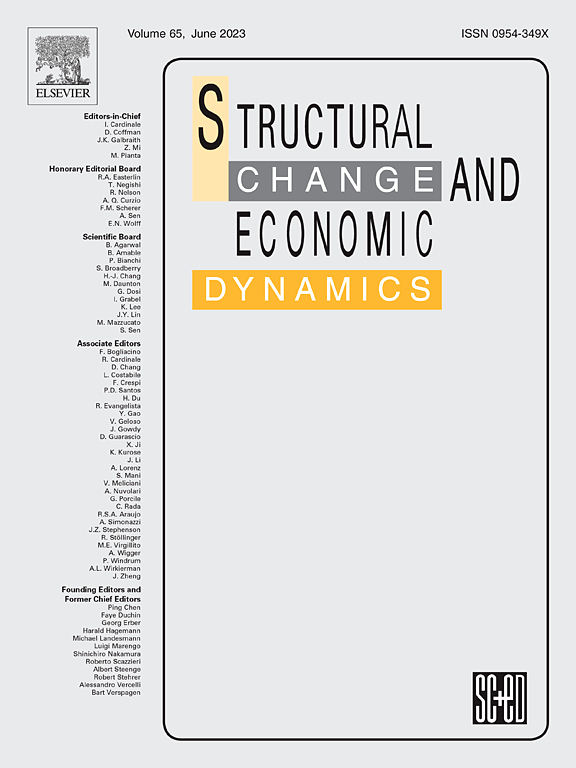Identifying critical EU carbon emissions risk through global value chains
IF 5.5
2区 经济学
Q1 ECONOMICS
引用次数: 0
Abstract
Global value chains (GVC) are a key element in discussions about trade dependencies/bottlenecks and recent EU policy proposals. Similarly, carbon-emissions reduction measures feature predominantly in the design of EU strategies and require sector-detailed knowledge about where emissions are generated along GVC.
We use input-output techniques to identify carbon upstream and downstream sectoral hotspots within EU’s GVC and classify industries according to their exposure to changes in carbon-related and trade policy. We introduce a novel (climate-reshoring, CRI) index to measure carbon dependency and apply it to sectors currently targeted by EU policy for potential backshoring.
Our results show that sectors demanding and supplying high-carbon-emissions goods are different, implying that EU countries' differences in exposure depend on their industrial structure and trade patterns. Top downstream-imported emissions come from Russian refined petroleum products, while upstream-emissions EU hotspots include Electricity & gas, Basic metals from China and Russia, and Chinese Chemical and Other non-metallic products. Regarding CRI, the sectors most at risk by carbon dependencies and trade disruptions are Computer, electronic and optical equipment; Pharmaceutical; and Electrical equipment, all identified as critical by EU’s Open Strategic Autonomy. Core-EU economies and large Southern countries show the highest levels of CRI, mainly due to their dependence on critical foreign sectors rather than a high imported emissions risk index.
These findings highlight the need to consider sectoral-level carbon exposure in policy-making. Specific measures aimed at increasing the UE production in sectors and countries with high CRI would be beneficial both in terms of resilience and climate-change fight.
通过全球价值链识别关键的欧盟碳排放风险
全球价值链(GVC)是讨论贸易依赖/瓶颈和最近欧盟政策建议的关键因素。同样,碳减排措施在欧盟战略设计中占主导地位,需要对全球价值链中产生排放的地方有详细的部门知识。我们使用投入产出技术来识别欧盟全球价值链中的碳上游和下游热点行业,并根据其对碳相关政策和贸易政策变化的影响对行业进行分类。我们引入了一个新的(气候回流,CRI)指数来衡量碳依赖,并将其应用于目前欧盟潜在回流政策所针对的行业。我们的研究结果表明,高碳排放商品的需求和供应部门是不同的,这意味着欧盟国家的暴露差异取决于其产业结构和贸易模式。上游进口的排放主要来自俄罗斯的精炼石油产品,而上游的欧盟排放热点包括电力和安普;天然气,来自中国和俄罗斯的基本金属,以及中国的化工和其他非金属产品。就CRI而言,受碳依赖和贸易中断影响最大的行业是计算机、电子和光学设备;制药;电气设备,所有这些都被欧盟的开放战略自治确定为关键。欧盟核心经济体和南方大国表现出最高的CRI水平,这主要是由于它们对关键外国部门的依赖,而不是高进口排放风险指数。这些发现突出了在决策过程中考虑部门层面碳暴露的必要性。旨在提高高CRI部门和国家的UE产量的具体措施将有利于恢复力和应对气候变化。
本文章由计算机程序翻译,如有差异,请以英文原文为准。
求助全文
约1分钟内获得全文
求助全文
来源期刊

Structural Change and Economic Dynamics
ECONOMICS-
CiteScore
9.60
自引率
4.90%
发文量
159
期刊介绍:
Structural Change and Economic Dynamics publishes articles about theoretical, applied and methodological aspects of structural change in economic systems. The journal publishes work analysing dynamics and structural breaks in economic, technological, behavioural and institutional patterns.
 求助内容:
求助内容: 应助结果提醒方式:
应助结果提醒方式:


